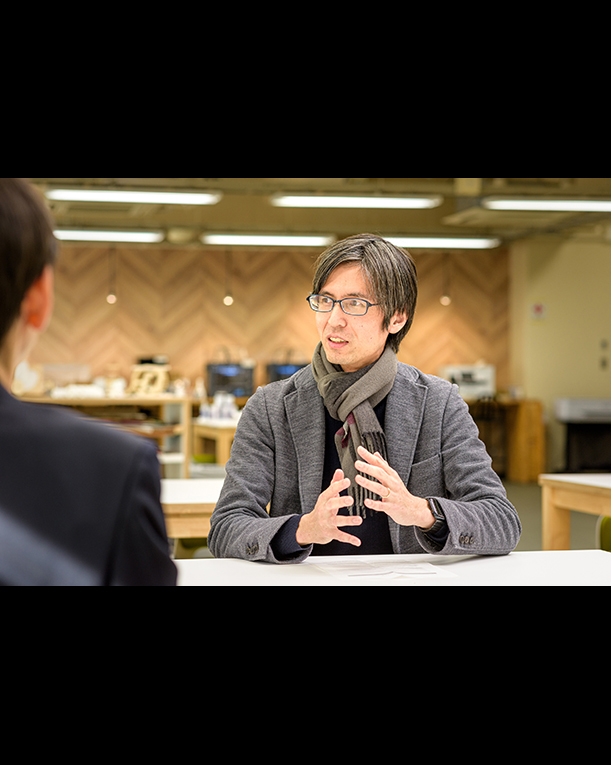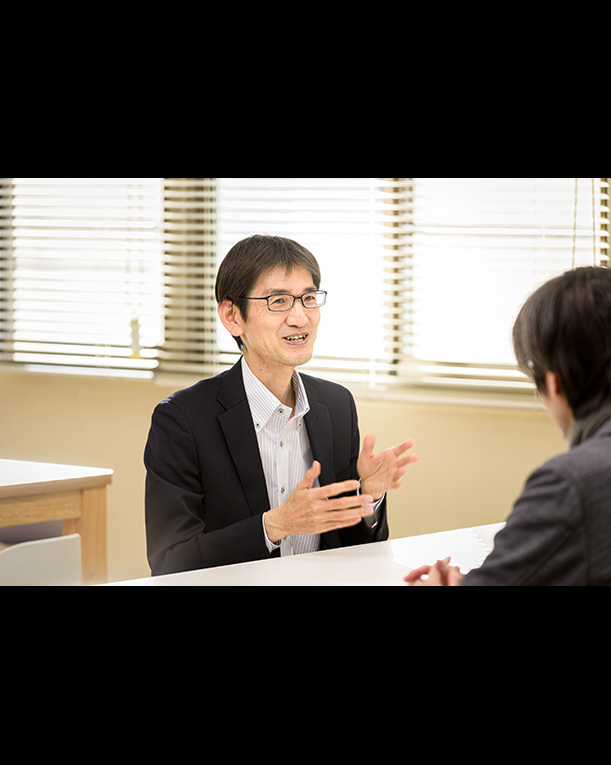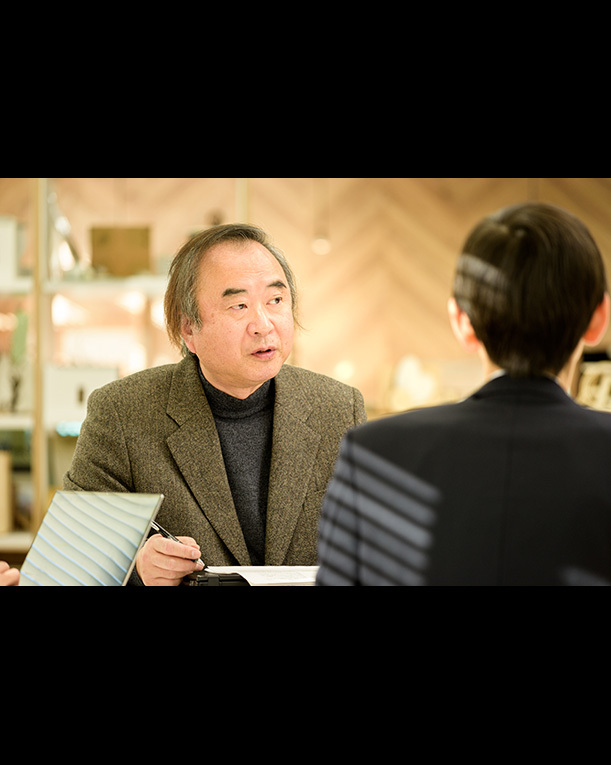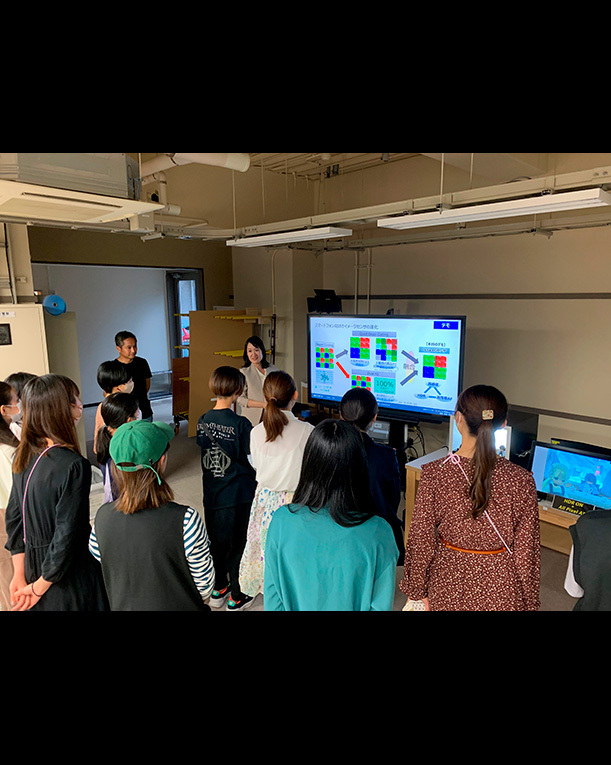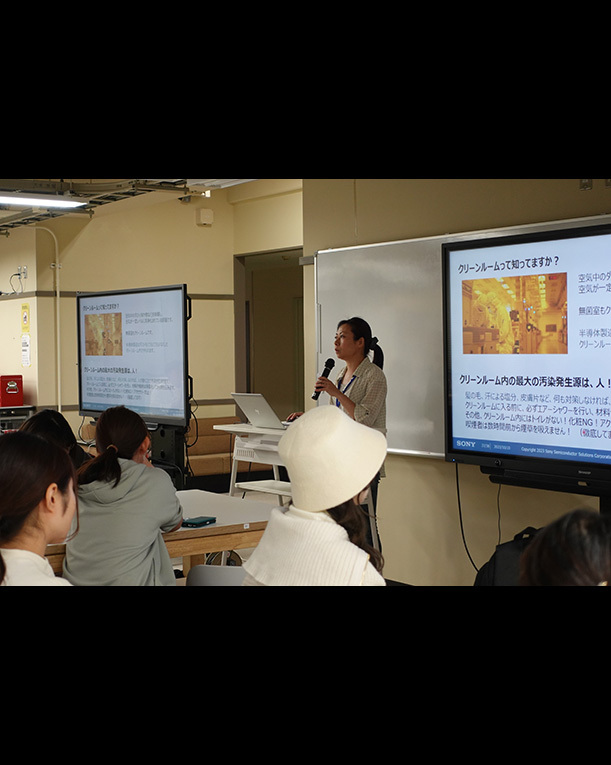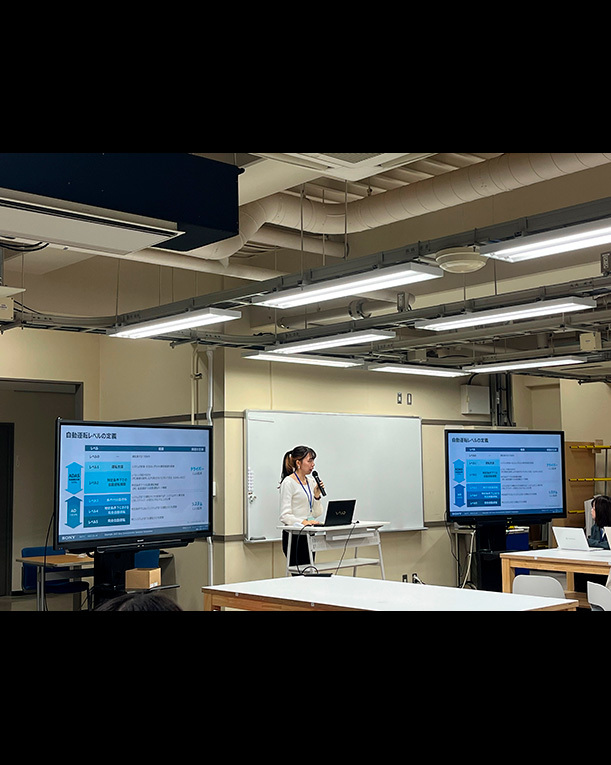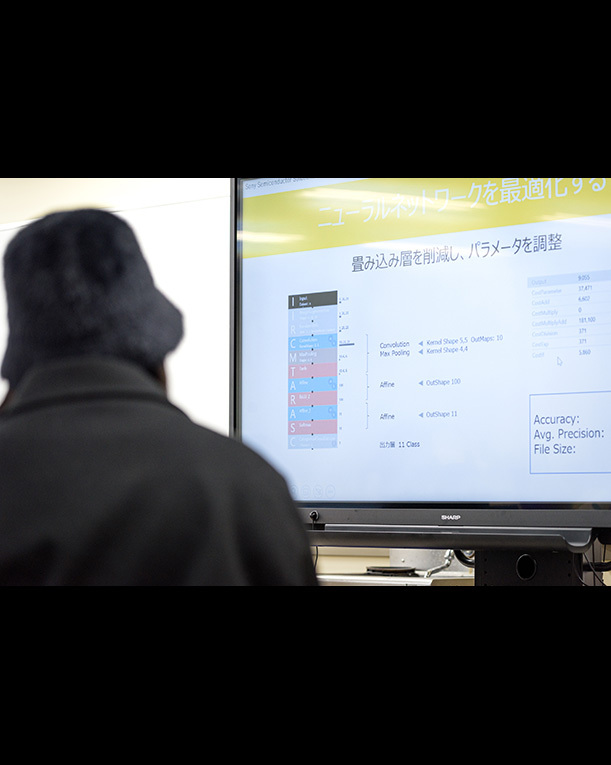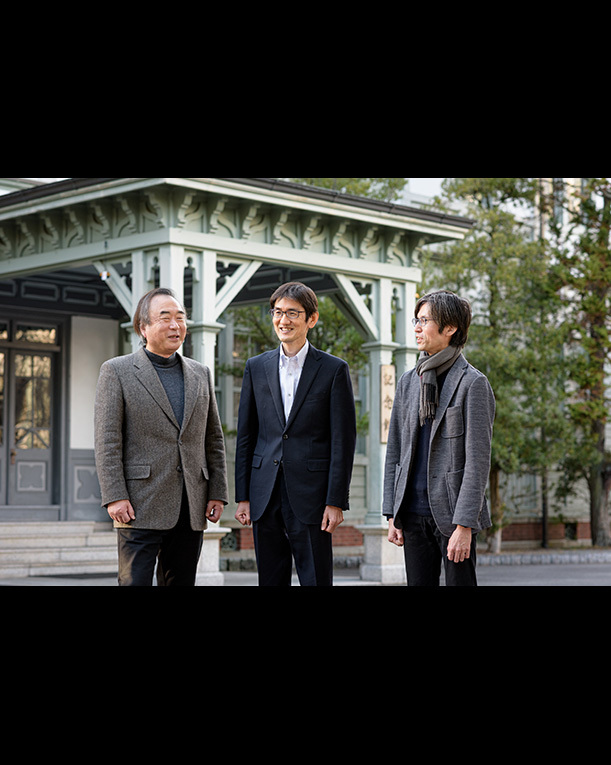
Describing image sensor technologies being applied to smartphones while giving demonstration.
Lecture on the design and manufacturing of image sensors. Explanation was given about the indoor environment required for production and the effort to prevent occurrence of contamination in clean rooms where cutting-edge semiconductors are manufactured.
A lecture on image sensors applied to self-driving. The female employee who took charge of the lecture said, “I kept it in mind to communicate in easy-to-understand words without frequently using technical terms. It gave me a precious opportunity to get fresh ideas from students’ perspective and recognize anew the potential of image sensors.”
Attempt at the Development of Female Engineers!
“Sensor Engineering” Course of Nara Women’s University Realizing Three-Way Satisfaction of University, Students and Company
2024.05.17
Nara National Institute of Higher Education and Research Nara Women’s University, (hereinafter “Nara Women’s University”) and the Sony Group are carrying out multi-faceted activities under the theme of elimination of gender bias and promotion of diversity through comprehensive partnership for the development of next-generation human resources.
As part of the activities, the Faculty of Engineering, Nara Women’s University opened the Sensor Engineering Course in the curriculum for the second half of 2023. Sony Semiconductor Solutions Corporation (SSS) gave classes by engineers being active on the front line of the respective image sensor fields.
We have interviewed Professor Naoki Saiwaki and Associate Professor Katsunari Sato at Nara Women’s University and Tetsuji Sumioka of SSS, who has taken charge of the development of this curriculum, to ask about the thoughts they put into this course and the results produced.
Saiwaki Naoki
Professor of Nara Women’s University
Director of Center for NARA Colleges Collaboration
Sato Katsunari
Associate Professor of Nara Women’s University
Sumioka Tetsuji
Sony Semiconductor Solutions Corporation
Imaging & Sensing Edge Core Technology Div.
Aiming at the development of female engineers capable of applying various sciences to promote research and development with their own actions and ideas
- Tell us about the human resources development aimed at by the Faculty of Engineering, Nara Women’s University
(Associate Professor Sato)
One characteristic of the Faculty of Engineering, Nara Women’s University is that there are no separate departments. Generally, one faculty often have separate departments such as Mechanical Engineering, Electrical Engineering and Electronic Engineering but integrating them into one department gives students the opportunity to come in contact with various fields such as Materials engineering, Information engineering and Biomedical engineering.
For example, one of the subjects of the Informatics area is Introduction to Measurement Engineering. This science itself is very useful also for those desiring to learn Materials engineering, Architecture and Environmental engineering, and Biomedical engineering. To any science, other sciences are often applied. Technology talents I want to develop are those capable of working on research and development while gaining an understanding of how those subjects can be made useful and applied and going through a trial and error process by their own actions and ideas.
(Professor Saiwaki)
In particular, we specialize in the human interface part and either hardware or software alone is insufficient. So I want them to understand humans themselves as well.
For example, when attempting to build a wonderful system, how far its specifications are pursued is one thing and ease of use of the system is quite another. The point is to design from various perspectives without placing disproportionate weight on one idea or perspective.
- It is important to refine one technology to achieve an improvement of a certain percentage but what essential meaning does the improvement have? I make it a point to give classes in which students can deepen their understanding of various values and education while developing their own individuality and interest to facilitate constructive discussions from a wide perspective.
- I hear that it was the first attempt for you to formulate a curriculum with a total of 15 class sessions. How did you move ahead with planning?
(Sumioka)
SSS has experience of giving lectures at various universities and I thought I could take advantage of the know-how from those activities. However, we had been told that the university wanted to leave everything about the Sensor Engineering course, including all of the 15 sessions of 90 minutes, to Sony. To be honest, I thought it would be tough to put that much content together. Meanwhile, I also had an image that, if SSS was to plan a course curriculum, interesting classes could be organized by making use of the features of the Sony Group, which covers a wide range from the development of image sensors to manufacturing of various products.
Image sensors are used in a real variety of applications such as automobiles and AR/VR, not to mention smartphones. I thought that, rather than just giving lectures on image sensors themselves, offering opportunities for students to see and feel through actual products what could be achieved by utilizing them would be greatly inspiring to them.
I also kept it in mind to gather lecturers with as diverse backgrounds as possible because the content varies for every lecture. In particular, I thought that female lecturers would also provide role models for students and wanted to gather many of them.
We actually asked employees of SSS and Sony Corporation being active at the forefront of the respective fields to teach in classes, all of whom willingly agreed. It made me aware of how all of them were motivated to develop female human resources in technology.
Thinking backward from use cases of application to consider technologies that provide the necessary basis.
To be a model case of classes meeting the demands of the times
- How did you find the curriculum proposed by Sumioka?
(Associate Professor Sato)
I thought it was very interesting. At universities, we are obliged to proceed with lectures systematically from the basics and touch upon the application part where the technology is used at the very end. The course planned by Sumioka-san took up diverse types of application as the themes and also included practical exercise. I found the content appealing.
The approach of thinking backward from the situations of use and considering which technologies are necessary for the purposes provides intriguing classes for students. I thought it was beneficial in that it would make clear what was lacking in their knowledge and what they should learn in the future.
(Professor Saiwaki)
When we were children, we had real-world experience about the mechanisms of machines acquired by taking a radio apart, for example. However, we are now in an age when answers to any question can be found just by searching. As a way of learning in the Faculty of Engineering for a generation who have lost the experience of gaining real experience, the course structure of starting with application of image sensors, which are products, and going back to the technology used in them, which provides the basis, would meet the demands of the times and provide a model case of future classes.
- Could you describe the content of the lectures actually given?
(Sumioka)
I paid the most attention to helping students imagine what jobs they will take when they join a company after graduating from the Faculty of Engineering.
What we as SSS are good at is image sensors. So we started with description about them and explained to students that they were applied to smartphones, which are familiar to them, while giving them hands-on demonstration. Image sensors are mounted on cameras in the form of camera modules including lenses, which is also explained in a class included in the curriculum.
We also explained that they could contribute to very important areas for humans and society including various applications such as, apart from smartphones, automobiles, industrial equipment and wearables with AR/VR and even watching over the earth.
In addition, we gave classes on the design and manufacturing of image sensors, signal processing such as localization and 3D model generation and utilization of AI and also practical exercise of combining an actual image sensor with AI to run a software application on a single-board computer. In this way, we sought facilitation of students’ visualizing how they would join a company in the future and move forward with research and development through their own actions.
Having them picture an image of themselves working in the future through listening to what female engineers have to say and visiting an office
- What was the response like of students who took the lectures?
(Associate Professor Sato)
For slightly difficult parts, lecturers skillfully broke the points down to explain and students’ satisfaction was quite high. The questionnaire survey results showed more than 75% of the students gave the highest mark and nobody said that the classes were too difficult to keep up with.
(Professor Saiwaki)
I observed classes and was impressed by the instructors’ adeptness in explaining visually.
In addition, it is only possible with Sony but explanation was given based on technologies put into practical application. There was a comment that, to students, “it is very real and makes reliability felt.” So I thought the classes were highly satisfactory to students.
(Associate Professor Sato)
I have heard that the visit to the Osaka Office and questions and answers session with female employees were helpful for the future and very meaningful to students. Opportunities are rare to see the work styles and places of work of those who are actually working, especially women in technology, and it must have been immensely inspiring.
- What did you find difficult in providing 15 class sessions?
(Sumioka)
In the past experience, our course was intended for those with a certain degree of technical background such as training in companies and lectures for graduate students but the audience was sophomore students this time. How much they would understand and to what degree we should break down were totally unknown and we paid close attention to the level of lectures.
However, it made the lecturers feel all the more rewarded when they found out from the comments and questions in the questionnaire survey after the classes that the students understood pretty well.
“I could form an image of the link between studies at universities and society”
Comment in the questionnaire survey of feeling the significance of the course
- What discoveries did you make through this initiative?
(Associate Professor Sato)
After all, it was good to have an opportunity to listen to employees who are actually working for a company and have made successes in their respective fields. It was beneficial for students to have been able to imagine work styles for when they join a company and want to be an engineer in the future.
I realize that the method of lecturing centered on applications intended for learning the knowledge and technology required for them, in addition to the conventional style of lectures that builds up from the basics with the focus on knowledge and technology, was effective for improving students’ motivation and understanding. I rediscovered the importance of making clear the image of the exit of technology and see the big picture of the links between elemental technologies.
(Professor Saiwaki)
While the Sensor Engineering course is based on classroom lectures and not exercise, providing opportunities to actually touch and experience during classroom classes, rather than separating between classroom lectures and exercise, has led to promotion of understanding of what has been learned. This way of proceeding with classes has served as a useful reference for the future.
Thanks to the opportunity to listen to engineers with various backgrounds (in terms of nationality, what they studied when they were students, the types of jobs they are currently engaged in, etc.), students could learn about the realities such as the level required for working in companies and how fundamental technologies are applied and incorporated into products, which I think made a whole lot of difference.
In interviews, many students made comments along the lines of “I had an image that universities were divided from society but, through this course, I could form an image of the link between studies at the universities and society.”
- Tell us about your future outlook.
(Professor Saiwaki)
The present course turned out to be a fascinating attempt and both I and Associate Professor Sato think we learned a great many things. This experience is too precious to be confined to the two of us. We think other instructors really should observe as well, as part of faculty development of the university. For improving the quality of education, we have so far provided opportunities to observe classes given by instructors with high marks from students but the style of one instructor speaking has remained unchanged.
I think that the present course with Sony is the fruit of a genuine effort to pursue the theme of how to have students interested and help them deepen understanding, going beyond the existing concept of classroom lectures. I thought that these classes should be widely shared in the university.
(Associate Professor Sato)
In the future, we can take one step forward and organize an event or project that students themselves can take part in, like internship (e.g. collaboration with the SSS employees who gave classes, in the form of an extracurricular activity spun off from classes, so to speak). It will probably further improve the quality of education, which is an idea I got through this initiative.
(Sumioka)
When I was a student, there were only two female classmates in the same department of the Faculty of Engineering. I’m sure many people were in a similar environment but, for creating innovations and new technologies, diverse human resources are required. We were given a wonderful experience this time and I want each of the employees who taught classes to bring back the fruit to their workplaces and apply it to the development of environment that further facilitates success of female engineers.
We would naturally be happy if many of the students and female engineers who took the course this time could come to SSS. If they find jobs at other companies, their success can revitalize engineering of Japan, which would lead to realization of an even better society. We intend to continue to be active in taking various initiatives.

